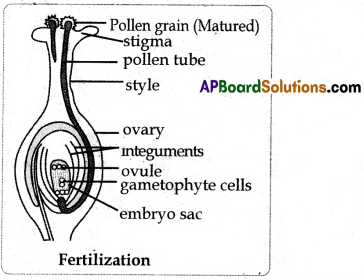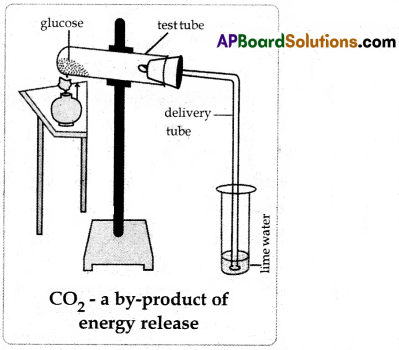Teachers often recommend practicing with AP 10th Class Biology Model Papers Set 6 to enhance exam readiness.
AP SSC Biology Model Paper Set 6 with Solutions
Time : 2.00 hours
Max.Marks : 50
Instructions :
- Question paper consists of 4 sections and 17 questions.
- Internal choice is available only for Q.no. 12 in section III and for all the questions in section IV.
- In the duration of 2 hours, 15 minutes of time is allotted to read the question paper.
- All answers shall be written in the answer booklet only.
- Answers shall be written neatly and legibly.
SECTION – I
(6 × 1 = 6 M)
Note :
- Answer all the questions.
- Each question carries 1 mark.
Question 1.
Absorbic acid is a water soluble vitamin. Give an example for a fat soluble vitamin.
Answer:
Retinol
Question 2.
Identify the picture with the help of the parts.

Answer:
Capellaries
Question 3.
Observe the flow chart and find ‘A’.
![]()
Answer:
Alveoil
![]()
Question 4.
He is a Botanist. He proved through experiments that roots not only absorb fluid from soil, but returns a portion of peculiar secretions. Who is he ?
Answer:
Brugman
Question 5.
Identify the mis-matched one.
| 1. Nissl’s granules | Cyton |
| 2. Myelin shealth | Axon |
| 3. Nodes of ranvier | Dendrites. |
Answer:
3 (Nodes of ranvier – Dendrites)
Question 6.
Identify the group of analogous organs.

Answer:
Group – B (Wing of a bird, Wing of a bat).
![]()
SECTION – II
(4 × 2 = 8 M)
Note :
- Answer all the questions.
- Each question carries 2 marks.
Question 7.
Leaves prepare substance ‘A’ through photosynthesis. It is converted into substance ‘B’. What are A and B ?
Answer:
Leaves prepare glucose (A) through photosynthesis. Glucose is converted into starch (B) and stored in plants
Question 8.
How swarms of insects suddenly appear in rainy season ?
Answer:
Insects have stages like egg, larva, pupa and adult stage in their life cycle. Most insects have life cycles spanning from a few days to few months. So they turn into adults at once and come out.
Question 9.
What is the difference between Homozygous and Heterozygous ?
Answer:
| Homozygous | Heterozygous |
| It refers to having two identical alleles for a single trait. | It refers to having two different alleles for a single trait. |
Question 10.
Justify that rains are not only the reason for floods but also human mistakes.
Answer:
- Failure of infrastructure
- Faulty darns maintenance
- Constructions in flood prone areas.
- Deforestation
These are all the human mistakes responsible for floods.
![]()
SECTION – III
(5 × 4 = 20 M)
Note :
- Answer all the questions.
- Each question carries 4 marks.
Question 11.
Write four questions you ask your doctor to know more information about edema ?
Answer:
- What is edema?
- What are its symptoms?
- What are the reasons for edema?
- What precautions are to be taken to prevent edema?
Question 12.
A) Draw a neat labelled diagram of nephron.
Answer:

(OR)
B) Draw a neatly labelled diagram that explains plant fertilisation.
Answer:

Question 13.
Why do butterflies flutter on and around flowers ?
Answer:
- Ripen stigma secretes sugary substance called nectar.
- This nectar stimulates the pollen grain which falls on the stigma.
- Butterflies use this nectar as their food.
- Hence they often flutter on and around matured flowers.
![]()
Question 14.
Write some slogans for protection of Environment.
Answer:
- Save the environment – Life will be better.
- If you save Nature – Will have better future.
- Environment is the heart of man.
- Plants in Environment – Save life.
Question 15.

A) Which test is required to know bilirubin ?
Answer:
Blood Test
B) How is the sugar disease confirmed ?
Answer:
If glucose in blood is above the normal application range ie. 60 -100 mg./dl. before food and 160 -180 mg./dl after food, we confirm sugar disease / diabetes.
C) By observing the above report, what could be the other problems faced by that patient ?
Answer:
Sugar/diabetes, Jaundice, Renal problems, Cardiac problems.
D) What are the organs affected by these problems ?
Answer:
Heart, kidney, liver.
![]()
SECTION – IV
(2 × 8 = 16 M)
Note :
- Answer all the questions.
- Each question carries 8 marks.
- Each question has internal choice.
Question 16.
A) Read the given para and answer the questions.
We know that the nerve cell is the structural and functional unit of nervous system. Our nervous system consists of around about 10 billion of them, which communicate with each other in a specific manner. Dendrites of one nerve cell connect to the other or to the axons of the other nerve cell through connections called a’synapse’.
i) Define neuron.
Answer:
The structural and functional unit of nervous system is called neuron.
ii) Where is synapse formed ?
Answer:
Dendrites of one nerve cell connect to the other or to the axons of the other nerve cell through connections called synapse.
iii) What are chief organs that are linked with 10 billion neurons ?
Answer:
Nerves are connected with Brain and Spinal cord.
iv) How is neuron divided into parts ? What are they ?
Answer:
Two parts
(a) Cyton,
(b) Axon.
(OR)
B) Suggest a simple experiment to prove the role of palate in recognising taste.
Answer:
Aim : To prove the role of palate in recognising taste.
Requirements : Sugar, stopwatch, dropper.
- Take some sugar crystals on the tongue.
- Keep the mouth opened and see that your tongue doesn’t touch the palate.
- Record the time from the moment of placing the sugar crystals on tongue till it got the taste by using stopwatch.
- Now repeat the test by placing the sugar crystals on the tongue and pressing it against the palate.
- Record the time from placing sugar crystals to getting the taste.
- Or put a drop of sugar solution on your tongue by using dropper and record the time.
Inference:
We can recognise taste quickly only when the tongue touches the palate.
![]()
Question 17.
A) Write the experiment you have performed in your school laboratory to know the action of saliva on flour. How did you test the pH of saliva ?
Answer:
Aim : To understand the action of saliva on flour.
Apparatus & Chemicals :
- Test tube
- Water
- Ata flour
- Watch glass
- Iodine solution and
- Saliva.
Procedure:
- Take a test tube, half filled with water and add a pinch of flour to it. Shake the test tube well till the flour gets mixed.
- Take a few drops of this in a watch glass and test for the presence of starch by putting a drop of diluted tincture iodine in it.
- A blue black colour formed, confirms the presence of starch.
- Now divide the mixture into two equal halves by transferring it to another test tube.
- Note that both test tubes have equal amounts.
- Add a tea-spoon of saliva to one of the test tubes and mark it.
- Do not add anything in another test tube.
- After sometime add a drop of diluted tincture Iodine solution to test tubes containing the solution.
Observation:
- The solution of the test tube to which saliva is added shows no colour change as starch is converted to sugar.
- There is a colour change to black in the other test tube to which saliva is not added.
Precautions while doing the experiment:
- Do the procedure gently while adding the reagents.
- We should see that there must be equal division of flour and iodine mixture solution before testing with saliva.
Testing pH of saliva:
- Collect a strip of pH paper with a colour chart from chemistry teacher.
- Take a small piece of the pH paper and touch it to your tongue.
- Match the colour with the colour chart and note the pH.
![]()
(OR)
B) What are your observations in combustion of sugar activity ?
Answer:
Aim : To observe the combustion of sugar and record the observations.
Apparatus : Glucose, test tubes, delivery tube, lime water, cork, stand and burner.

Procedure :
- Small amount of glucose is taken in a test tube. It is closed with cork. The apparatus is fixed on the stand and heated over flame.
- After certain time sugar melts and chars and produces carbon dioxide, water and energy.
Observation:
- First the sugar chars. Then it gives flame as it melts.
- The heat is liberated at a time.
- When glucose burns CO2 and water are produced.